
Toona, commonly known as redcedar, toon or toona, tooni is a genus in the mahogany family, Meliaceae, native from Afghanistan south to India, and east to North Korea, Papua New Guinea and eastern Australia. In older texts, the genus was often incorporated within a wider circumscription of the related genus Cedrela, but that genus is now restricted to species from the Americas.
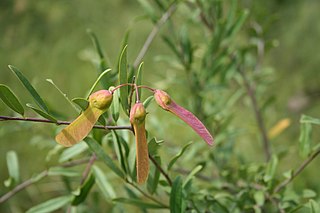
The Polygalaceae or the milkwort family are made up of flowering plants in the order Fabales. They have a near-cosmopolitan range, with about 27 genera and ca. 900 known species of herbs, shrubs and trees. Over half of the species are in one genus, Polygala, the milkworts.
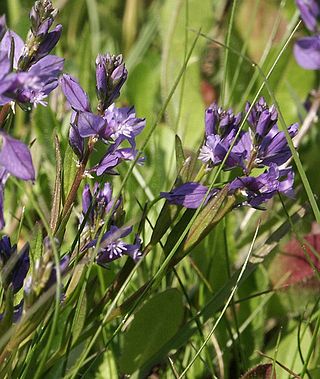
Polygala is a large genus of flowering plants belonging to the family Polygalaceae. They are commonly known as milkworts or snakeroots. The genus is distributed widely throughout much of the world in temperate zones and the tropics. The genus name Polygala comes from the ancient Greek "much milk", as the plant was thought to increase milk yields in cattle.

Polygala vulgaris, known as the common milkwort, is a herbaceous perennial plant of the genus Polygala in the family Polygalaceae.

Toona ciliata is a forest tree in the mahogany family which grows throughout South Asia from Afghanistan to Papua New Guinea and Australia.

Gentianella is a plant genus in the gentian family (Gentianaceae). Plants of this genus are known commonly as dwarf gentians.

Lysimachia ciliata, the fringed loosestrife, is a species of flowering plant in the family Primulaceae. It is an erect herbaceous perennial growing to 120 cm (47 in) tall and 60 cm (24 in) broad, with opposite, simple leaves, and smooth green stems. The star-shaped yellow flowers are borne in midsummer. It is native to North America, including most of southern Canada and most of the United States except for the southwest. This plant is notable in that it is one of the few species of Lysimachia to bear elaiophores, that is, to offer oil instead of nectar as a reward to pollinators. It is pollinated in the northern part of its range by the specialist oil bee Macropis nuda, a native bee species whose survival depends upon this host plant.
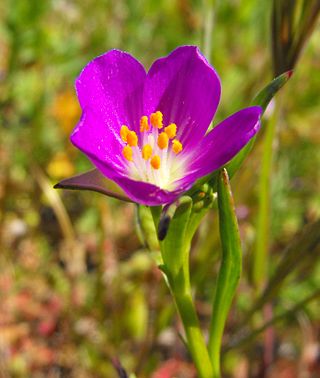
Calandrinia ciliata is a species of flowering plant known as fringed redmaids and red-maids. While formerly included in the Purslane family, it is now treated as a member of the family Montiaceae.

Corythucha ciliata, the sycamore lace bug, is a species of lace bug in the family Tingidae that is associated with sycamore trees. It's also known as the plane lace bug due to its association with the London plane.

Populus ciliata, the Himalayan poplar, is a large deciduous tree with tall clean straight trunk and wide rounded crown. The bark of the young trees is smooth and greenish-grey while the bark of the old trees is dark brown with vertical cracks. Leaves are broadly ovate with hairy serrulate-crenate margins. Flowers are drooping raceme catkins that appear before or with leaves. Populus ciliata flowers are dioecious. Male flowers have a bell-shaped perianth and female flowers are bluntly toothed. A single capsule encloses an average of 100–150 seeds, which are covered by long silky hair.

Micromyrtus ciliata is a species of flowering plant in the family Myrtaceae and is endemic to south-eastern continental Australia. It is a spreading to erect shrub with crowded, oblong to egg-shaped leaves and small white or pink flowers arranged singly in upper leaf axils, forming clusters on the ends of branches.

Blephilia ciliata is a species of herbaceous perennial plant in the Lamiaceae (mint) family native to central and eastern North America. It is commonly called downy wood mint. Other common names include downy pagoda-plant, sunny woodmint and Ohio horsemint.
Eremophila ciliata, commonly known as Archer's eremophila is a flowering plant in the figwort family, Scrophulariaceae and is endemic to a small area in the south of Western Australia. It is an erect, spreading shrub with short, thick leaves and small lilac to mauve flowers. It is only known from a population of about 100 plants.
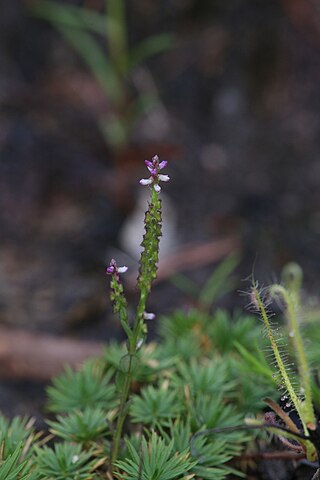
Salomonia is a genus of plants in the family Polygalaceae, the milkwort family. They are annual herbs with erect or ascending stems, aromatic roots, simple alternate leaves and axillary, terminal spike inflorescence.

Olearia ciliata, commonly known as the fringed daisy bush, is a small shrub with large clusters of bright purple-blue flowers on a single stem.
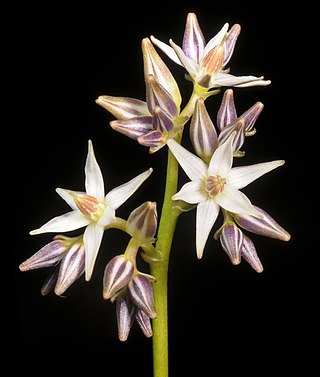
Phlebocarya filifolia is a plant in the Haemodoraceae family, native to Western Australia.

Phlebocarya ciliata is a plant in the Haemodoraceae family, native to Western Australia.
Cryptandra ciliata is a species of flowering plant in the family Rhamnaceae and is endemic to south-eastern Queensland. It is a shrub with clustered linear leaves and densely-hairy, white, tube-shaped flowers.

Brachyloma ciliatum, commonly known as fringed brachyloma or fringed daphne heath, is a species of flowering plant in the family Ericaceae and is endemic to south-eastern Australia. It is a low-lying or erect shrub with upwards-pointing, egg-shaped to oblong leaves and white, tube-shaped flowers.

Xanthosia ciliata is a species of flowering plant in the family Apiaceae and is endemic to the south-west of Western Australia. It is a low spreading shrub with linear leaves and yellowish-green to cream-coloured or white flowers.

















